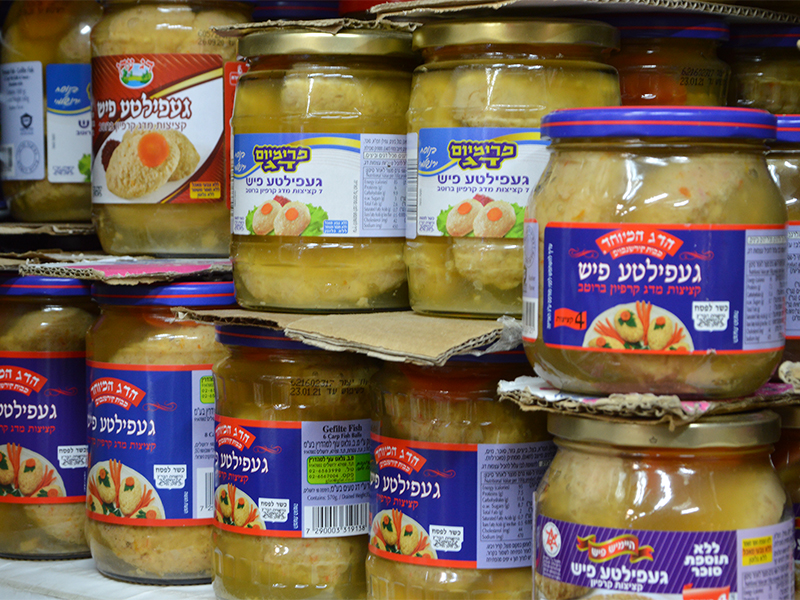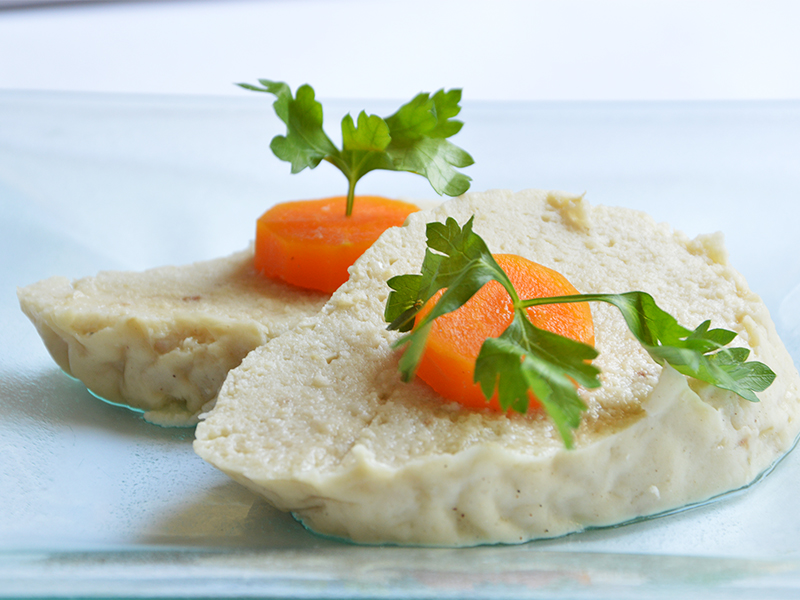 The ’Splainer (as in “You’ve got some ’splaining to do”) is an occasional feature in which the RNS staff gives you everything you need to know about current events to hold your own at the water cooler.
The ’Splainer (as in “You’ve got some ’splaining to do”) is an occasional feature in which the RNS staff gives you everything you need to know about current events to hold your own at the water cooler.
(RNS) — When Jews gather around the table for Passover seder, the ritual meal commemorated this year on March 30 and 31, many will begin the feast with an oval-shaped appetizer, often mounted on a single leaf of lettuce and crowned with a boiled carrot medallion on top.
Meet gefilte fish, a culinary connection to the shtetls, or ancestral towns of many Jews of Eastern European origin.
To mask its usual blandness (and, some would say, gastronomic sadness), Jews will often add grated horseradish, or horseradish mixed with beets, to make it more palatable. Before passing the platter, here’s what you need to know about this much-maligned food that is making — slowly — a gourmet comeback. Let us ’Splain …
What is gefilte fish?
Gefilte fish is the love-it-or-hate-it ground fish dish that Jews have traditionally served as a first course on Friday night’s Sabbath meal, but also on Passover and at other holidays. “Gefilte” means “stuffed” in Yiddish, and originally the forcemeat was stuffed into whole fish such as pike or carp. Today, the fish is usually deboned, chopped and/or ground and mixed with matzo meal, onion, eggs and seasonings, then shaped into oval balls poached or boiled in fish stock before being eaten at room temperature or cold from the fridge. Wags have dubbed it “the pescatarian’s meatloaf” and “the hot dog of the sea.”
And like meatloaf, gefilte fish picked up flavors and versions as Jews wandered the world. In Poland, gefilte fish is sweet; in Lithuania, it is peppery. And in modern Brooklyn, gefilte fish can be found made with sustainably raised fish, quinoa and “micro arugula” and served with a global array of flavors: Asian (soy or teriyaki sauce); Moroccan (turmeric and chickpeas), Mexican (con jalapeños) and even “Indian-Jewish” (mangoes and tamarind).
But the vast majority of Jews eat it straight from a vacuum-sealed jar sold in supermarkets.
How did gefilte fish get so, um, delish?
Like a lot of ethnic foods, gefilte fish arose out of poverty and need. It was first created by Ashkenazi Jews — Jews of European origin — who relied on it to feed their families while staying kosher. The Jewish Talmud prohibits the removal of bones on the Sabbath, so how to serve fresh fish? The answer was to skin and debone the fish before the Sabbath’s start at sundown and mix it with other ingredients to make it stretch. Because there is no cooking on the Sabbath, the dish was often served cold.
How did the poached version become the weird-looking jarred version now on store shelves?
That, like so much that is kitschy today, is a mid-20th-century invention. In 1935, the Heinz Co. became the first mass market food company to commit to making kosher products, quickly followed by Coca-Cola. After World War II, the influx of Jewish immigrants, many of them kosher-keeping, brought wider distribution of kosher products. With the introduction of new food technologies in the 1950s, the kosher food industry exploded, and the Jewish food that was among the most suitable for preservation was gefilte fish. Put it in a jar with broth or a jellylike goo derived from boiled fish bones and it can last on the shelves for a year.
But that innovation came at a cost.

Jars of gefilte fish for sale in Israel. Photo by Mushki Brichta/Creative Commons
“Bland, intractably beige, and (most unforgivably of all) suspended in jelly, the bottled version seemed to have been fashioned, golem-like, from a combination of packing material and crushed hope,” food writer Rebecca Flint Marx wrote of the Manischewitz jarred gefilte fish of her Midwestern childhood. ” … It refused assimilation or window-dressing; it was straight out of the shtetl.”
Today, while Manischewitz has 16 versions of jarred gefilte fish (“fishlets” in jelled broth, anyone?) a younger generation of Jews and foodies is reclaiming gefilte fish and giving it a makeover. Chief among them are the three millennials behind The Gefilteria, a Brooklyn (of course!) Jewish food producer that published “The Gefilte Manifesto” cookbook in 2016.
“Gefilte is not just about your bubbe,” The Gefilteria’s owners write, using the Yiddish word for grandma. “Gefilte is about reclaiming our time-honored foods and caring how they taste. … It’s about reclaiming the glory of Ashkenazi food — what it has been and what it can be.”
Why is fish so dominant a part of the Jewish gastronomic experience?
Anyone who’s ever been to a bar mitzvah, a Jewish wedding or a Jewish dinner party will no doubt have eaten salmon, the most ubiquitous of Jewish fish. Partly, that’s because Jewish dietary laws allow fish to be eaten with either meat or dairy meals. But it’s more than that.
In Jewish lore, fish is a symbol of fertility and a sign of the coming of the Messiah, who, according to legend, will come in the form of a great fish from the sea. Claudia Roden, the doyenne of Jewish cooking, says fish was customary at Jewish tables from the earliest of times. Jews bought it on Thursday (and keep it swimming in the bathtub), killed it on Friday and made it the highlight of the Friday evening meal.
In her book “97 Orchard: An Edible History of Five Immigrant Families in One New York Tenement,” Jane Ziegelman writes: “Along with the Sabbath candlesticks, the oblong gefilte fish pot, a vessel dedicated to that one food, was among a handful of objects that the Jewish housewife carried with her to America.”
Are there any good gefilte fish jokes?
Probably some, but not many. Here’s a taste:
Q: What kind of cigarettes do Jewish mothers smoke?
A: Gefiltered.
A decade ago, there was this nod to pork: “Gefilte Fish: The Other White Meat.” And the satirical magazine Heeb posted YouTube clips of gefilte fish wrestling.
But in the main, the foodstuff has remained more maligned than funny, particularly in its jarred incarnation. Like the Maxwell House Haggadah, it is the stuff of suburban Jewish legend that Jews carry with them from one generation to the next.





